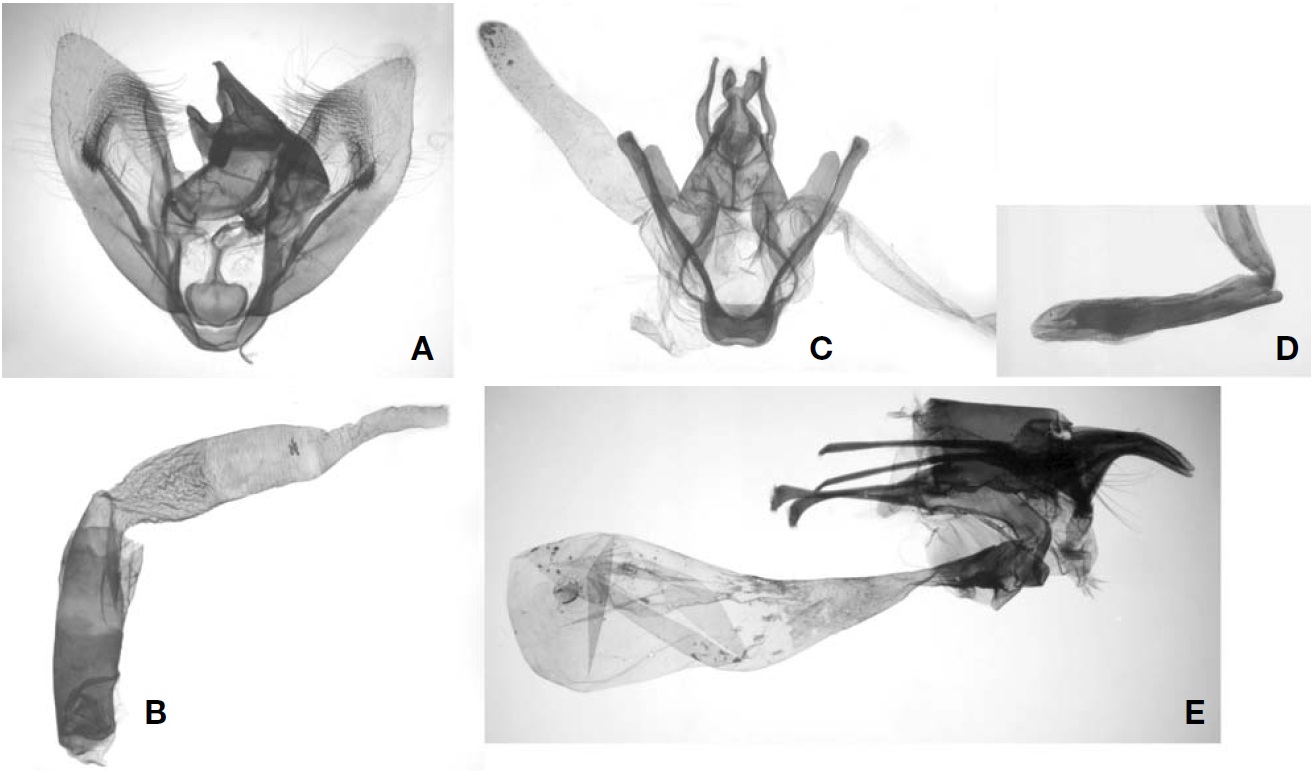



Genus
Genus
In the present study, two ennomine species,
Order Lepidoptera Linnaeus, 1758
Family Geometridae Stephens, 1829
Subfamily Ennominae Duponchel, 1845
Genus Amblychia Guenee, [1858]
Type species:
1*Amblychia angeronaria Guenee, [1858] (Figs. 1,2)
Material examined. Korea: JN: 1♂6♀, Isl. Gageo-do, N34°03′50′′, E125°07′18′′, 348 m, 5 Jun 2012; 1♀, Isl. Gageo-do, N34°04′24′′, E125°06′00′′, 185 m, 5 Jun 2012; 1♂5♀, Isl. Gageo-do, N34°04′16′′, E125°06′26′′, 228 m, 5 Jun 2012; 1♀, Isl. Gageo-do, N34°04′24′′, E125°06′00′′, 185 m, 10 Sep 2012.
Diagnosis. This species is characterized by the long pectinations of the male antennae, the larger wingspan, a row of white triangular dots on the postmedian fascia of forewing, a dark brown medial line and blackish discal dot on fore and hindwings and undulating postmedial line of hindwing. The male genitalia can be distinguished by the strongly tapered and apically bifid uncus, the large spatulate gnathos, the large and rounded juxta, and the membranous and apically projected valva, with large setae-like hairs on the costa and cucullus. The female genitalia can be distinguished by the long and medially curved ovipositor, the long and sclerotized apophyses, the broad antrum, the short ductus bursae, and the long membranous corpus bursae with a rounded signum with dentate margin.
Description. Wingspan 67-75 mm. Head: Antennae in male bipectinate with long pectinations (Fig. 1A), in female filiform (Fig. 1B); frons broad, ventrally projected, covered with dark ochreous scales; labial palpi long, almost twice to eye diameter, well projected beyond frons covered with dark ochreous hairs. Thorax: Body and legs covered with yellowish white hairs. Forewing: Ground color ochreous; basal line dark ochreous, suffused with white dots; medial line dark ochreous, slightly rounded; one dark brown discal dot; postmedial line with a row of large whitish triangular dots; termen with dark brown or blackish, undulating subterminal line; apex with one large, light ochreous dot. Hindwing: Ground color brownish in male and dark ochreous in female; medial line dark ochrous; discal dot blackish; postmedial line blackish, undulating; termen with dark ochreous rounded subterminal line; margin medially sharply pointed outward.
Male genitalia (Fig. 2A, B). Uncus long, strongly tapered, apex weakly bifid; gnathos spatulate; tegumen triangular, almost equal to length of vinculum; transtilla ring-shaped; juxta large, heart-shaped; saccus short, broad. Valva long, strongly tapered, apex projected; costa slender, sclerotized, distally with long setae-like hairs; sacculus long, sclerotized; cucullus basally with setae-like hairs. Aedeagus long, rodshaped; vesica tubular with small patch of cornuti.
Female genitalia (Fig. 2E). Ovipositor lobe long, medially curved, distally sharply pointed; apophyses posteriores strongly sclerotized, long, almost equal to length of apophyses anteriores; antrum broad; ductus bursae short, tapered, sclerotized; corpus bursae long, pear-shaped, signum rounded sclerotized plate-shaped with dentate margin.
Host plant. Lauraceae (Sugi, 1987).
Distribution. Korea, Japan, Taiwan, Borneo, Sumatra, North
East Himalaya.
Remarks. The species is bivoltine in Korea, flying June and September.
Genus Peratostega Warren, 1897
Type species:
1*Peratostega deletaria (Moore), 1888 (Figs. 1,2)
Material examined. Korea: JJ: 1♂ Seonheul, Jocheon, N33°16′5.6′′, E126°27′22.8′′, 16 Jul 2010, Kim SS; 1♂ Hareri, Seogwipo-si, N33°19′56.7′′, E126°36′25.7′′, 499 m, 2 Oct 2010, Choi SW.
Diagnosis. This species can be distinguished by the brownish wings, dark ochreous dentate postmedial line of fore and hindwings and light yellowish apical dot of the forewing. The male genitalia can be distinguished by the bifid uncus, long digitate gnathos, membranous costa and long and sclerotized saccullus of valva, and a pair of long coremata pouch on valva.
Description. Wingspan 26 mm. Head: Antennae in male filiform (Fig. 1C); frons narrow, covered with ochreous and dark ochreous scales; labial palpi strongly upturned, projected beyond frons covered with ochreous hairs. Thorax: Body and legs covered with yellowish white hairs. Forewing: Ground color light brownish; postmedial line dark brown, thick, rounded; apex with large light yellowish dot. Hindwing: Ground color brownish; basally dark brownish; postmedial line dark brownish, dentate; termen medially projected.
Male genitalia (Fig. 2C, D). Uncus expanded, bifid; gnathos long digitate; tegumen triangular, almost equal to length of vinculum; saccus short, broad. Valva long, slender; costa slender, membranous; sacculus long, strongly sclerotized; a pair of coremata pouch present. Aedeagus long, rod-shaped; vesica tubular with linear patch of cornuti.
Female genitalia. Not examined.
Host plant.
Distribution. Korea, Japan, Taiwan, North India.
Korean name: 1*큰노랑남방가지나방 (신칭)
Korean name: 1*남방검회색가지나방 (신칭)

